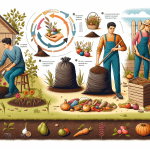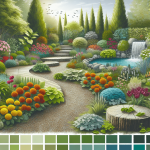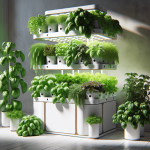This post may contain affiliate links. As an Amazon Associate, we may earn commissions from qualifying purchases.
If you’ve ever wondered how to invite helpful critters into your garden, you’re in luck! This article will explore the various ways you can attract beneficial insects to your garden and reap the rewards of their presence. From pollination to pest control, these tiny allies can make a world of difference in maintaining a healthy and thriving garden. So, if you’re ready to learn some simple techniques to attract these helpful creatures, read on!
Creating an Attractive Habitat
Provide diverse plant life
To attract beneficial insects to your garden, it is important to provide a diverse range of plant life. Having a variety of flowers, herbs, vegetables, and even trees, will create a habitat that is attractive to beneficial insects. Different insects are attracted to different types of plants, so by incorporating a wide selection, you increase your chances of attracting a diverse array of beneficial insects.
Choose native plants
When selecting plants for your garden, prioritize native species. Native plants are already adapted to your local environment and are more likely to attract local beneficial insects. These insects have evolved alongside native plants and depend on them for food and shelter. By choosing native plants, you are providing a familiar and valuable resource for beneficial insects.
Include flowering herbs and vegetables
In addition to ornamental flowers, consider including flowering herbs and vegetables in your garden. Many herbs, such as dill, fennel, and yarrow, have beautiful flowers that attract beneficial insects like ladybugs. Vegetables such as carrots, peas, and tomatoes also produce flowers that can be beneficial in attracting pollinators.
Plant in clusters
Planting in clusters rather than scattering individual plants throughout your garden can be more effective in attracting beneficial insects. Clusters of plants create a larger and more noticeable target, making it easier for insects to locate and navigate towards them. This technique also provides a concentrated source of food and shelter, which can help support and sustain beneficial insect populations.
Using Companion Planting
Plant flowers alongside vegetables
Companion planting, which involves planting different species of plants together, can be a helpful practice in attracting beneficial insects. By planting flowers alongside your vegetables, you create a more attractive and enticing environment for beneficial insects. The flowers provide nectar and pollen sources for them to feed on, while the vegetables offer additional food sources and habitat.
Select companion plants that attract beneficial insects
When choosing companion plants, opt for those that have been proven to attract beneficial insects. For example, marigolds are known to attract hoverflies, which are beneficial predatory insects that help control aphids. Nasturtiums are another great companion plant as they can attract aphids away from your other crops, acting as a sacrificial plant. Thyme and mint are also good choices as they attract bees and predatory wasps.
Rotate flowering plants throughout the season
To keep the beneficial insects coming all season long, consider rotating different flowering plants throughout your garden. By staggering the blooming periods of various plants, you ensure a continuous supply of nectar and pollen sources for beneficial insects. This can be achieved by choosing plants with different blooming seasons or by planting different annual flowers at different times.
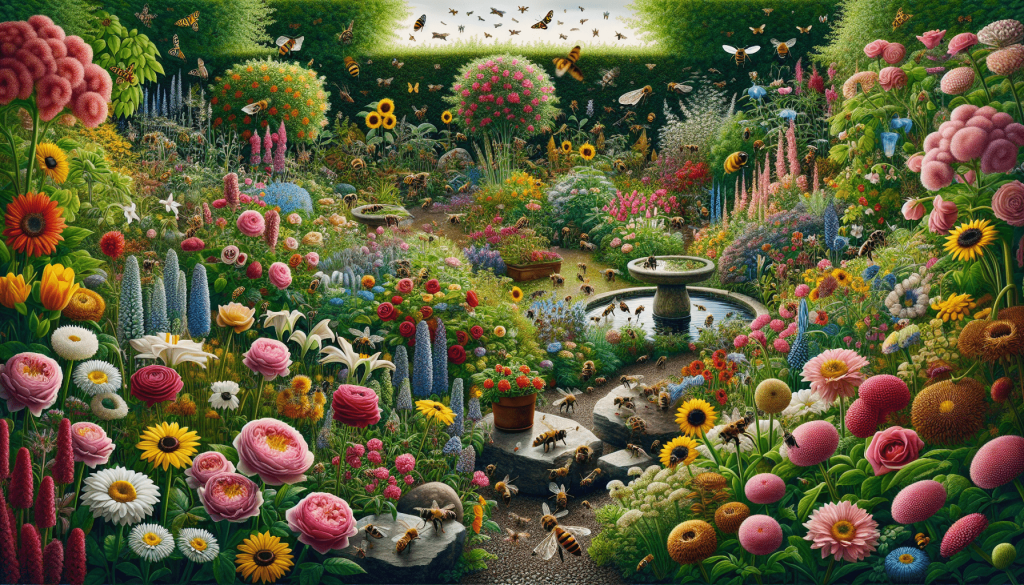
Avoiding Pesticides
Minimize pesticide use
One of the most important steps in attracting beneficial insects is to minimize the use of pesticides. Pesticides can be harmful not only to harmful insects but also to beneficial ones. To minimize pesticide use, consider alternative methods of pest control and only use pesticides as a last resort when other control methods have failed.
Use organic pest control methods
Instead of relying on chemical pesticides, opt for organic pest control methods. These methods include using biological controls, such as introducing beneficial insects like ladybugs or lacewings that prey on pests. You can also use physical barriers, like row covers or netting, to protect your plants from pests. Additionally, practicing good garden sanitation, such as removing plant debris and cleaning up fallen fruits, can help prevent pest infestations.
Avoid chemical insecticides
Chemical insecticides should be avoided whenever possible as they can harm both beneficial insects and the environment. Some insecticides have long-lasting effects, persisting in the soil or water and disrupting the natural balance of ecosystems. Instead, focus on organic and natural alternatives that target specific pests without harming beneficial insects.
Providing Water Sources
Install a water feature
To attract beneficial insects, it is essential to provide a water source in your garden. Installing a water feature, such as a birdbath, fountain, or small pond, can be an effective way to attract and provide water for beneficial insects. Make sure to keep the water feature filled with fresh water and clean it regularly to prevent the breeding of mosquitoes.
Place shallow dishes with water
In addition to a larger water feature, placing shallow dishes or saucers filled with water throughout your garden can provide smaller, more accessible water sources for beneficial insects. These dishes can be placed on the ground or strategically positioned on rocks or other elevated surfaces. Keep the water level shallow to prevent drowning and change the water frequently to avoid stagnant conditions.
Keep water sources clean
Maintaining clean water sources is crucial for attracting and keeping beneficial insects in your garden. Remove any debris or leaves that may accumulate in the water, as they can create a breeding ground for pests. Regularly clean and refill the water sources to ensure that they remain fresh and inviting for beneficial insects.
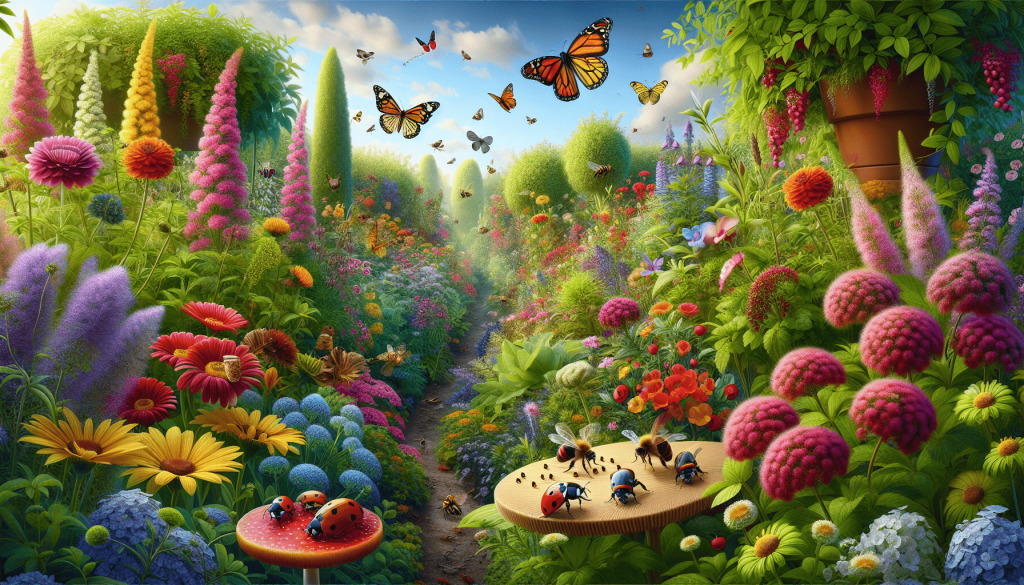
Creating Shelter and Nests
Leave areas of undisturbed vegetation
Creating shelter and nesting opportunities for beneficial insects involves leaving areas of undisturbed vegetation in your garden. It is important not to overly tidy or remove all the weeds, fallen leaves, or dead plant material. These areas provide shelter, nesting sites, and overwintering spaces for beneficial insects like bees, ladybugs, and lacewings.
Provide nesting materials
Some beneficial insects, such as solitary bees, require specific materials for nesting. To attract these bees, provide bundles of hollow stems, like bamboo or reeds, or create bee houses specifically designed for nesting. Ladybugs, on the other hand, benefit from having access to a variety of plants that can provide them with shelter and a place to lay their eggs.
Build bee houses and insect hotels
Building bee houses or insect hotels can be a fun and creative way to provide shelter and nesting sites for beneficial insects. These structures can be made from natural materials like bamboo canes, hollowed-out logs, or stacks of wooden blocks. By including different sizes of holes and cavities, you can cater to the nesting needs of various beneficial insects.
Maintaining Healthy Soil
Add organic matter
To maintain healthy soil and support beneficial insects, it is important to add organic matter to your garden. Organic matter improves soil structure, fertility, and water-holding capacity, making it more conducive to the growth of beneficial insects and plants. Compost, well-rotted manure, or other organic materials can be added to enrich the soil and promote a thriving ecosystem.
Avoid over-fertilization
While it is important to provide nutrients to your plants, it is equally important to avoid over-fertilization. Excessive use of fertilizers can lead to nutrient imbalances and harm beneficial insects. Instead, opt for slow-release or organic fertilizers, and follow recommended application rates. Regular soil testing can help determine the specific nutrient needs of your garden.
Use natural soil amendments
In addition to organic matter, there are natural soil amendments that can benefit both your plants and beneficial insects. For example, adding crushed eggshells or diatomaceous earth can help control pests like slugs or snails without harming beneficial insects. Seaweed extract or fish emulsion can serve as natural fertilizers and soil conditioners, providing essential nutrients for plants and the insects that rely on them.
Attracting Specific Beneficial Insects
For pollinators: provide nectar-rich flowers
To attract pollinators like bees, butterflies, and hummingbirds, it is crucial to provide a wide selection of nectar-rich flowers. Look for flowers that are native to your region and have different bloom times to ensure a continuous food source throughout the growing season. Some excellent choices include lavender, sunflowers, coneflowers, and bee balm.
For ladybugs: plant dill, fennel, and yarrow
Ladybugs are beneficial insects that prey on various garden pests, such as aphids and mites. To attract ladybugs, plant flowering herbs like dill, fennel, and yarrow. These herbs produce beautiful flowers that not only attract ladybugs but also provide them with pollen and nectar sources.
For bees: include bee-friendly plants like lavender and sunflowers
Bees are essential pollinators and play a crucial role in food production. To attract bees to your garden, include bee-friendly plants like lavender, sunflowers, borage, and salvia. These plants provide rich sources of nectar and pollen and will help support the health and populations of bee species.
Using Pheromone Traps
Use pheromone traps to lure undesirable insects away from the garden
Pheromone traps can be a useful tool to lure and trap undesirable insects away from your garden. Pheromones are chemical signals that insects use to communicate with each other. By using synthetic pheromones, you can attract and trap specific pest insects, such as moths or beetles, reducing their population and minimizing damage to your plants.
Place traps away from beneficial insect habitats
When using pheromone traps, it is essential to place them away from areas where beneficial insects commonly reside. Placing the traps too close to their habitats may inadvertently trap beneficial insects, disrupting the balance of your garden ecosystem. By strategically placing the traps away from beneficial insect habitats, you can effectively target pests while minimizing harm to beneficial insects.
Practicing Integrated Pest Management
Monitor pest populations regularly
Integrated Pest Management (IPM) involves monitoring pest populations regularly to determine the need for intervention. By regularly inspecting your plants, you can detect and identify early signs of pest infestations. This allows you to initiate control measures promptly, minimizing the need for pesticides and maximizing the effectiveness of alternative pest control methods.
Encourage natural predator-prey relationships
A crucial aspect of integrated pest management is encouraging and maintaining natural predator-prey relationships in your garden. Beneficial insects, such as ladybugs, lacewings, and parasitic wasps, can act as natural predators of garden pests. By providing them with suitable habitat, food sources, and nesting opportunities, you can support their populations and increase their impact on pest control.
Remove pests by hand when necessary
Sometimes, despite your best efforts, pests may still become problematic in your garden. In such cases, manually removing pests by hand can be an effective control method. Simply inspect your plants regularly and physically pick off pests, like caterpillars or slugs, and dispose of them appropriately. This targeted approach helps reduce overall pest populations without adversely affecting beneficial insects.
Engaging in Year-round Gardening Practices
Provide food and shelter during all seasons
To attract and support beneficial insects throughout the year, it is important to provide food and shelter during all seasons. Incorporate plants that bloom at different times of the year to ensure a continuous food source for beneficial insects. Additionally, leave some areas untouched during the winter to provide shelter and overwintering sites for insects.
Avoid pruning too aggressively
While pruning is a necessary gardening practice, it is important to avoid pruning too aggressively, especially during the nesting and breeding seasons of beneficial insects. Overly pruning can remove valuable food and shelter sources, disrupting the habitat for these insects. Instead, be mindful of the timing and extent of your pruning activities, ensuring that you leave enough plant material for beneficial insects.
Maintain a balance between cultivated and wild areas
Creating a balance between cultivated areas and wild or natural areas in your garden helps support a diverse range of beneficial insects. Cultivated areas provide a source of food and shelter through well-maintained plants, while wild areas offer a more natural and undisturbed environment. This combination ensures that you attract a wide variety of beneficial insects, contributing to a healthy and balanced garden ecosystem.
In conclusion, attracting beneficial insects to your garden is a valuable and eco-friendly way to promote natural pest control and enhance your garden’s overall health. By providing diverse plant life, practicing companion planting, avoiding pesticides, providing water sources, creating shelter and nests, maintaining healthy soil, attracting specific beneficial insects, using pheromone traps, practicing integrated pest management, and engaging in year-round gardening practices, you can create an attractive habitat that will draw in and support these beneficial insects. So get started today and watch as your garden becomes a thriving haven for beneficial insects and a flourishing ecosystem. Happy gardening!



